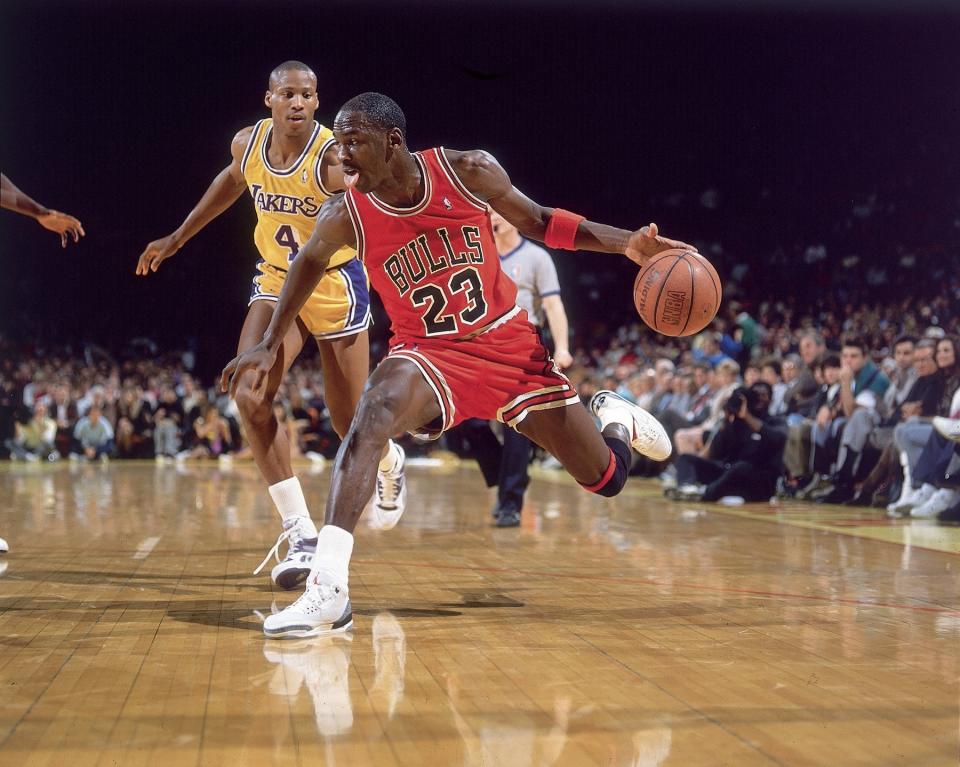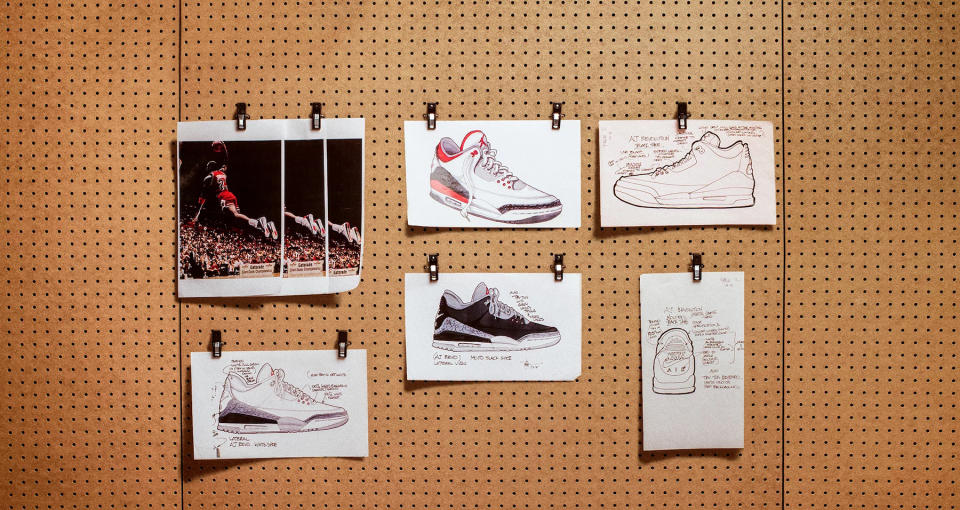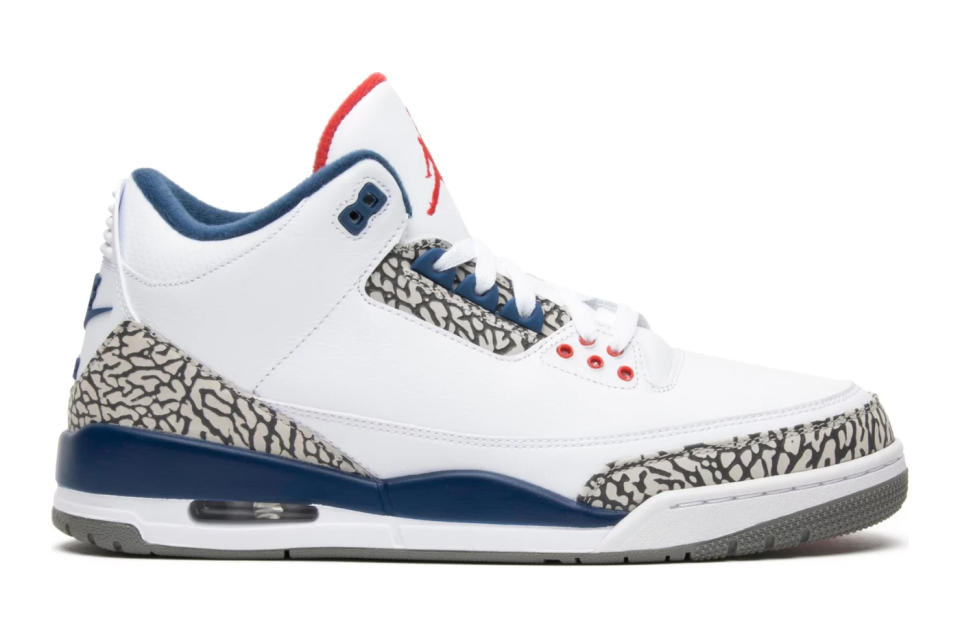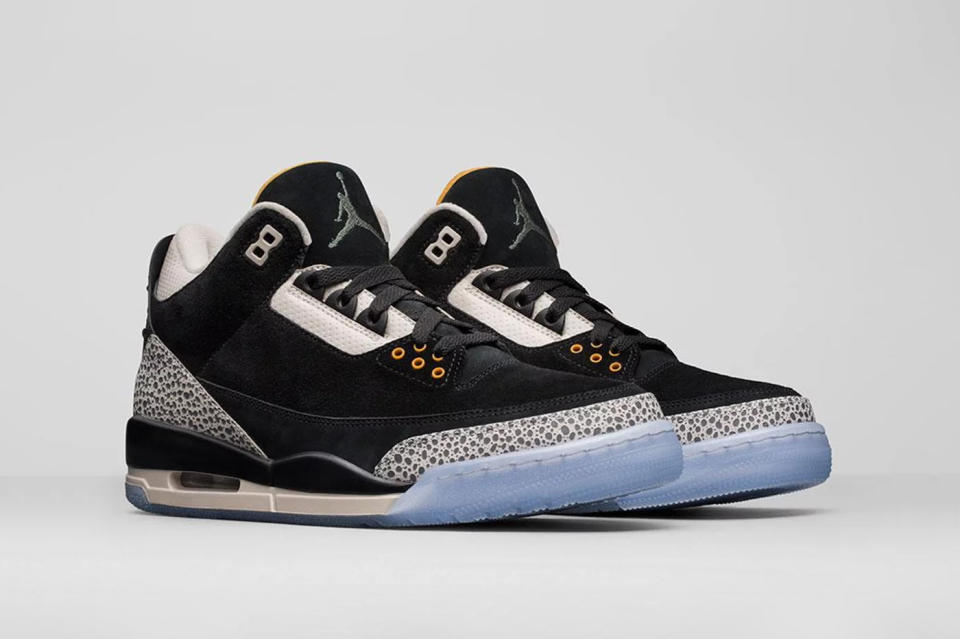Air Jordan 3 History & Timeline: Everything You Need to Know About the Air Jordan 3

More from Footwear News
A conversation on the greatest sneakers of all time can’t go without mention, and will often end with, the Air Jordan 3.
Michael Jordan’s third signature sneaker from Nike is widely beloved for a design unlike anything that had ever been seen before on a basketball shoe in equal parts of its historical significance. As the first of Jordan’s sneakers to be designed by the legendary Tinker Hatfield, the Air Jordan 3 helped prevent the superstar from leaving Nike, which very well may have saved the company. It also introduced the Jumpman logo to the world and brought Spike Lee’s Mars Blackmon character into the fold for one of the most heralded series of advertisements.
No hyperbole is involved when it comes to discussing the legacy of the Air Jordan 3, beginning with its inaugural release for $100 in 1988 up to highly sought-after collaborations that reinforce its relevance today such as the Nina Chanel Abney edition that’s in the middle of a two-pronged launch.
Below, Footwear News takes you through the history of the Air Jordan 3, including its design, original colorways, marketing and key collaborations.

Preventing Jordan From Leaving Nike
With his initial three-year contract with Nike set to run out, Jordan was heavily considering leaving Nike. His dream prior to signing with the Swoosh had been an Adidas deal, and he was being recruited by two recently departed Nike executives, designer Peter Moore and marketing vice president Rob Sasser, who were launching their own Van Grock Brand.
Further threatening to pull Jordan out of Nike was his dislike of the Air Jordan 2 (which still makes it a polarizing silhouette among sneakerheads to this day). The upper’s Italian leather was luxurious but too stiff and difficult to break in for Jordan’s liking. He also considered the sneaker ugly and found the thicker midsole reduced his feeling of the court compared to the Air Jordan 1.
Coming off of the success of the Air Jordan 1, Moore and fellow designer Bruce Kilgore were rushed to create its successor. After Moore had left, the less experienced Tinker Hatfield was also given a short timeline to put together concepts for the Air Jordan 3. Luckily for Nike, Hatfield quickly conceptualized a shoe so dazzling it would keep Jordan from straying. His Airness was three hours late to the Air Jordan 3’s initial presentation meeting because he had been golfing with Moore and Sasser, signaling just how close he was to leaving Nike in a move that very well could have prevented it from become the world’s chief sportswear brand.

Design, Technology and the Jumpman
Coming off of designing the Air Max 1, Nike’s first sneaker to showcase its Air technology externally, Hatfield also brought a visible Air unit to Jordan’s signature series for the very first time. The Air Jordan 3 was also heavily informed by Jordan’s own input, resulting in the three-fourths “mid” cut allowing for greater ankle movement and the supple tumbled leather serving as a direct counter to the stiffness of the Air Jordan 2.
This supple leather also brought texture throughout the Air Jordan 3’s upper, an effect amplified by the panels featuring an elephant print unlike anything that had ever been used on a basketball sneaker before. The most important aesthetic element of all, though, was the tongue’s embroidered silhouette of Jordan leaping in the air from a previous Nike campaign (which itself borrowed heavily from a Life magazine shoot by Co Rentmeester that would draw a lawsuit decades later). It was here that the Jumpman logo was born, and it’d go on to appear on every subsequent Air Jordan sneaker while becoming one of the most recognizable marks in the world.
Early concepts featured a stubby Swoosh beneath the lateral collar, as well as Nike text embroidered beneath the medial collar, but both elements would ultimately be removed to leave the mustache’s Nike Air logo as the sneaker’s lone mark for the brand.

Original Colorways
“White/Cement”
“Black/Cement”
“Fire Red”
“True Blue”
The Air Jordan 3’s original run only consisted of four colorways, three of which Jordan wore in an NBA setting. He favored the “White Cement” edition throughout the 1987-1988 regular season, and the colorway is most commonly associated with its appearance on his feet as he won the 1988 Slam Dunk Contest. Jordan would switch over to the “Black Cement” variant for that weekend’s NBA All Star Game, and come the playoffs he favored the “Fire Red” sneaker.
Because it didn’t match his Chicago Bulls uniform, the Air Jordan 3 “True Blue” wasn’t worn by Jordan on an NBA court until 2001 in his late-career run with the Washington Wizards.
Introducing Mars Blackmon
The Air Jordan 3’s last significant first came in its introduction of Spike Lee’s Mars Blackmon character to line’s marketing campaigns, another development that helped keep Jordan with Nike. The Jordan devotee originated from Lee’s 1986 Film “She’s Gotta Have It” and appeared in a pair commercials for the Air Jordan 3, beginning with one featuring the tagline, “Do you know?”
Mars Blackmon campaigns would continue through the early’90s on additional Air Jordan models, perhaps most famously in the Air Jordan 5’s “Is It the Shoes?” spot. Lee’s relationship with Jordan would also result in him getting his own Jordan Brand sneaker, the Jordan Spizike, which is a hybridization of the of the five sneakers Mars Blackmon promoted, the Air Jordan 3, Air Jordan 4, Air Jordan 5, Air Jordan 6 and Air Jordan 20.

Key Retros and Collaborations
The Air Jordan 3 was brought back for the first time in 1994 with the return of the “White Cement” and “Black Cement” editions, but is is the case for the Air Jordan line in general, the retro releases didn’t really begin to take off until the early 2000s.
2001 brought back the “Black Cement” once again, as well “True Blue” for the first time and the Air Jordan 3’s first-ever non-original colorway in “Mocha,” which swapped the heel’s Nike Air mark for the Jumpman. The “White Cement” version would then make its second-ever return in 2003, but it wouldn’t be until 2007 that the last remaining original colorway, “Fire Red,” would be reintroduced to the market for the first time.
2011 retros for the “White Cement” and “Black Cement” colorways brought Jumpman branding on the mustache, a decision that many sneakerheads weren’t happy with and were relieved to see resolved with the original branding returning on both in 2018.
The Air Jordan 3’s first collaboration would depend on how you define the term. A Doernbecher edition released in 2010 as a fundraiser for the children’s hospital of the same name, and SoleFly made a friends-and-family exclusive in 2014 that didn’t release to the public. Some might say the first true collaboration came in 2017, when Atmos borrowed its “Safari” print from its 2002 Air Max 1 in place of the signature elephant print.
Other key collaborations include the Justin Timberlake edition from 2018 that brought the Swoosh concept to life for the first time, as well as Fragment’s take on the sneaker in 2020 and A Ma Manieré‘s a year later. Eminem has a version of the Air Jordan 3 that’s never released to the public, as does DJ Khaled in two colorways.
About the Author:
Ian Servantes is a Senior Trending News Editor for Footwear News specializing in sneaker coverage. He’s previously reported on streetwear and sneakers at Input and Highsnobiety after beginning his career on the pop culture beat. He subscribes to the idea that “ball is life” and doesn’t fuss over his kicks getting dirty.
Best of Footwear News
C.P. Company's Best Shoe Collaborations Over the Years: Adidas, Clarks and More
Adidas Gazelle: Complete History & Timeline of the Classic Sneaker
Sign up for FN's Newsletter. For the latest news, follow us on Facebook, Twitter, and Instagram.
